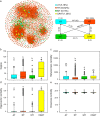Distinct patterns and processes of abundant and rare eukaryotic plankton communities following a reservoir cyanobacterial bloom
- PMID: 29899512
- PMCID: PMC6092360
- DOI: 10.1038/s41396-018-0159-0
Distinct patterns and processes of abundant and rare eukaryotic plankton communities following a reservoir cyanobacterial bloom
Abstract
Plankton communities normally consist of few abundant and many rare species, yet little is known about the ecological role of rare planktonic eukaryotes. Here we used a 18S ribosomal DNA sequencing approach to investigate the dynamics of rare planktonic eukaryotes, and to explore the co-occurrence patterns of abundant and rare eukaryotic plankton in a subtropical reservoir following a cyanobacterial bloom event. Our results showed that the bloom event significantly altered the eukaryotic plankton community composition and rare plankton diversity without affecting the diversity of abundant plankton. The similarities of both abundant and rare eukaryotic plankton subcommunities significantly declined with the increase in time-lag, but stronger temporal turnover was observed in rare taxa. Further, species turnover of both subcommunities explained a higher percentage of the community variation than species richness. Both deterministic and stochastic processes significantly influenced eukaryotic plankton community assembly, and the stochastic pattern (e.g., ecological drift) was particularly pronounced for rare taxa. Co-occurrence network analysis revealed that keystone taxa mainly belonged to rare species, which may play fundamental roles in network persistence. Importantly, covariations between rare and non-rare taxa were predominantly positive, implying multispecies cooperation might contribute to the stability and resilience of the microbial community. Overall, these findings expand current understanding of the ecological mechanisms and microbial interactions underlying plankton dynamics in changing aquatic ecosystems.
Conflict of interest statement
The authors declare that they have no conflict of interest.
Figures





Similar articles
-
Response of the eukaryotic plankton community to the cyanobacterial biomass cycle over 6 years in two subtropical reservoirs.ISME J. 2019 Sep;13(9):2196-2208. doi: 10.1038/s41396-019-0417-9. Epub 2019 May 3. ISME J. 2019. PMID: 31053831 Free PMC article.
-
Planktonic eukaryotes in the Chesapeake Bay: contrasting responses of abundant and rare taxa to estuarine gradients.Microbiol Spectr. 2024 May 2;12(5):e0404823. doi: 10.1128/spectrum.04048-23. Epub 2024 Apr 12. Microbiol Spectr. 2024. PMID: 38606959 Free PMC article.
-
DNA metabarcoding reveals that 200-μm-size-fractionated filtering is unable to discriminate between planktonic microbial and large eukaryotes.Mol Ecol Resour. 2017 Sep;17(5):991-1002. doi: 10.1111/1755-0998.12652. Epub 2017 Feb 3. Mol Ecol Resour. 2017. PMID: 28063202
-
Eukaryotic picoplankton in surface oceans.Annu Rev Microbiol. 2011;65:91-110. doi: 10.1146/annurev-micro-090110-102903. Annu Rev Microbiol. 2011. PMID: 21639789 Review.
-
A trait based perspective on the biogeography of common and abundant marine bacterioplankton clades.Mar Genomics. 2014 Jun;15:17-28. doi: 10.1016/j.margen.2014.03.002. Epub 2014 Mar 21. Mar Genomics. 2014. PMID: 24662471 Review.
Cited by
-
The dynamics of microbial community and flavor metabolites during the acetic acid fermentation of Hongqu aromatic vinegar.Curr Res Food Sci. 2022 Oct 4;5:1720-1731. doi: 10.1016/j.crfs.2022.10.002. eCollection 2022. Curr Res Food Sci. 2022. PMID: 36238813 Free PMC article.
-
Response of particle-attached and free-living bacterial communities to Microcystis blooms.Appl Microbiol Biotechnol. 2024 Dec;108(1):42. doi: 10.1007/s00253-023-12828-2. Epub 2024 Jan 6. Appl Microbiol Biotechnol. 2024. PMID: 38183480
-
Contrasting assembly mechanisms and drivers of soil rare and abundant bacterial communities in 22-year continuous and non-continuous cropping systems.Sci Rep. 2022 Feb 28;12(1):3264. doi: 10.1038/s41598-022-07285-2. Sci Rep. 2022. PMID: 35228617 Free PMC article.
-
Abundant and Rare Bacterial Taxa Structuring Differently in Sediment and Water in Thermokarst Lakes in the Yellow River Source Area, Qinghai-Tibet Plateau.Front Microbiol. 2022 Mar 29;13:774514. doi: 10.3389/fmicb.2022.774514. eCollection 2022. Front Microbiol. 2022. PMID: 35422785 Free PMC article.
-
Strong Host Modulation of Rhizosphere-to-Endosphere Microbial Colonisation in Natural Populations of the Pan-Palaeotropical Keystone Grass Species, Themeda triandra.Ecol Evol. 2025 Jun 18;15(6):e71595. doi: 10.1002/ece3.71595. eCollection 2025 Jun. Ecol Evol. 2025. PMID: 40534981 Free PMC article.
References
-
- Scheffer M, Carpenter SR. Catastrophic regime shifts in ecosystems: linking theory to observation. Trends Ecol Evol. 2003;18:648–56. doi: 10.1016/j.tree.2003.09.002. - DOI
-
- Moustaka-Gouni M, Vardaka E, Michaloudi E, Kormas KA, Tryfon E, Mihalatou H, et al. Plankton food web structure in a eutrophic polymictic lake with a history in toxic cyanobacterial blooms. Limnol Oceanogr. 2006;51:715–27. doi: 10.4319/lo.2006.51.1_part_2.0715. - DOI
Publication types
MeSH terms
LinkOut - more resources
Full Text Sources
Other Literature Sources

